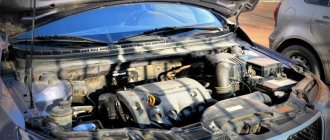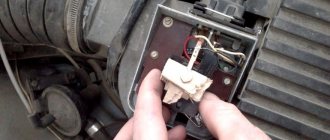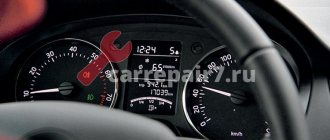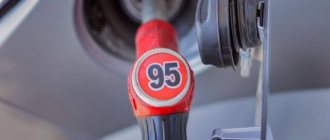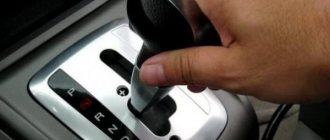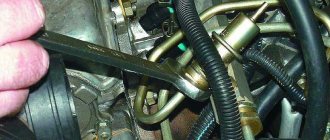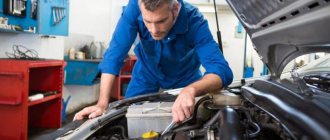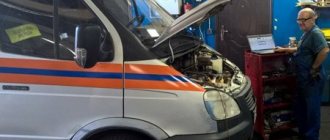Download PDF
Many drivers are interested in why the car jerks when pressing or releasing the gas pedal. Moreover, this problem manifests itself both on carburetors and injectors. And not every car service can find the reason. This is due to a large number of problems that can cause such behavior of the car. Often, a car enthusiast, having visited specialists, friends, and also visited several shamans, simply gets used to the idea that his car has such a feature. But, in fact, there is no such problem that cannot be eliminated (the only fatal problem is cricket in the “nine”), if you carefully check all possible causes, you can find a malfunction.
Content
Why does the car jerk when you press or release the pedal? On injectors, the culprit most often turns out to be an unadjusted throttle position sensor. In this case, the ECU (electronic control unit) reacts to changes with a delay and gives incorrect commands. This is why an incomprehensible twitching appears when the gas increases or decreases. The cause is eliminated by adjusting the sensor. After the adjustment, you can forget about the problem for a long time.
To work, you will need a tester; with its help, the sensor is called, and this entire system is brought to the proper readings.
Poor quality fuel
Sometimes, such symptoms appear shortly after refueling. Here you can be congratulated, you have filled in fuel that contains a suspension of solid particles. The twitching appeared due to clogged filters, and possibly nozzles. To fix it, you will have to clean the entire fuel system. This will take quite a lot of time, but there is simply no other option. Remember the gas station you refueled at and don’t go there again.
In the most difficult case, your injectors will become clogged. You can clean them yourself, without even removing them from the engine, but it will be much more effective to remove them and clean them on a special stand. In the best case scenario, low-quality fuel will contain water and will gradually be used up.
A malfunction of the electronic control unit often leads to the car jerking. The reason is incorrect readings, as well as incorrect commands. In this case, fuel injection is delayed. The problem can manifest itself not only when working with gas, but also in other modes. During computer diagnostics, an “ECU error” will be displayed.
The problem is resolved by reflashing the equipment. In particularly severe cases, the entire unit may need to be replaced. If you do not fix the problem, then problems with increased fuel consumption and other troubles will soon be added to the twitching.
Engine jerking while driving
- If, after gaining speed, power dips are observed, then, as a rule, the ignition system is to blame. This problem applies to all types of engines. Solution: turn off the ignition and check whether the block with wires fits tightly to the coil. After this, you need to start the engine again and listen to how it works. If characteristic clicks are heard, it means that a high voltage breakdown has occurred somewhere. Consequently, the block, high-voltage wires (and possibly the coil itself) will have to be changed.
- Another reason for jerking while driving is problems with gasoline. To identify them, remove the spark plugs and inspect them. If they have a white soot on them, similar to talc, it means that due to low-quality gasoline, a lean fuel mixture is entering the combustion chambers. Solution: drain the low-quality gasoline and refuel elsewhere.
A white coating on the spark plugs almost always indicates an unsuitable quality of the fuel mixture.
Carburetor
On carburetor engines, the reason may be jamming of the throttle valve, as well as the throttle cable. This results in improper power management of the vehicle. Usually it is enough to treat the throttle with special substances and develop it. You can also change the throttle cable. It may be rusty and preventing the throttle from opening/closing in a timely manner. Perhaps this is one of the simplest reasons for the car jerking when working with gas.
Ignition
. Ignition problems can also cause poor vehicle performance. Most often, this happens in conjunction with a general drop in engine power. If you experience twitching when moving, be sure to check that this system is working correctly. It is worth starting the check with the spark plugs; if they produce a bad spark, then it makes sense to continue the check.
Diagnostics
As you can see, there are plenty of reasons for problems with the car when working with the gas pedal. All that remains is to find out what the real reason is. To do this, you will have to check all of the listed systems. It’s better to start with computer diagnostics. This will most likely allow you to identify the faulty node. But this does not always happen. A faulty ECU is identified with a high degree of accuracy; the rest may not generate errors. In this case, the TPS does not produce any errors at all. The fact is that, although it is incorrect, it works, and the control unit believes that everything is normal.
To determine the exact cause, you will have to manually check all the nodes that could cause this problem. Various additional factors can be evaluated to speed up the process. For example, an ignition problem is accompanied by a loss of power. Fuel system blockages appear soon after refueling. By assessing the accompanying signs, you will find the cause much faster.
Conclusion
. As a rule, car twitching is the result of a failure of settings in systems related to engine control and operation. To determine why the car jerks when you press or release the gas pedal, you will have to carry out quite a lot of different actions. After all, there may be several reasons for this, but it is simply impossible to determine by eye what has fallen off in your case.
To post a reply you must log in or register.
The main reason for the car “jerking” when you press the gas pedal
The main reason is most often associated with an oxygen-rich/oxygen-depleted fuel mixture. It is because of the lack of air that the crankshaft continues to rotate despite the fact that the gas pedal has long been released. In addition, when the pedal is pressed sharply, the motor begins to twitch and rotate in place.
The root cause of the problem is preparing the wrong mixture. In turn, the mixture can be supplied to the engine in different proportions due to malfunction of other devices and components of both the engine and the fuel system.
Car jerking due to TPS malfunction
TPS is a special sensor that regulates the position of the throttle valve. It is quite simple to understand that the malfunction is connected with it - the engine begins to “jump” even when the accelerator is gently pressed. The process of jerking is as follows:
- The throttle remains ajar for a long time;
- After this, during acceleration, a faulty throttle position sensor belatedly transmits a signal to the on-board computer of the car;
- As a result, the car’s engine cannot quickly switch from idle to full speed in load mode, after which fuel is supplied in large quantities and sharply into the combustion chamber;
- The result is a sharp decrease in pressure in the fuel rail design. The engine will run jerkily at first, and then completely stall.
This type of malfunction can often be found in vehicles with injection engines. Both domestic cars (Lada Priora, Lada Vesta Cross, Lada Granta) and foreign car models (for example, the same Ford Focus) are not immune from this. In this case, there is only one solution - go to a car service center, where they will replace the faulty sensor.
Advice: do not try to solve the problem yourself by repairing a faulty TPS. As a rule, after repair, a previously faulty mechanism can last no more than 1-2 months.
Car jerking due to a malfunction of the mass air flow sensor
The second sensor that affects the air supply to the system is a device for regulating the mass flow of oxygen in the system. It works in injection-type engines and is responsible for supplying air during the formation of the fuel mixture. If this component is faulty, then your car will also twitch before it even has time to accelerate. The solution is similar with the first sensor - dismantling and completely replacing the mass air flow sensor.
Car jerking - malfunction in the carburetor chamber and pump
If the engine starts to run jerkily in carburetor cars even when the gas pedal is lightly pressed, the main attention should be focused on the carburetor chamber. The problem is often associated with clogged outlets, which are located in the first of the carburetor chambers.
When the fuel enters the engine, it takes with it some of the soot and metal shavings, as a result of which the mixture undergoes changes and the engine operates unstably. You can solve this problem yourself - just remove the carburetor and blow out all its pipes and holes with compressed air.
A classic example is the following situation: when replacing the front wheel bearing on a VAZ-2109, the pump was damaged. As a result of the failure of the carburetor accelerator pump, the mixture is supplied to the engine in an incomplete volume. The result is the appearance of jerks during even a smooth attempt to move away. In most cases, it seems impractical to repair pumps, which is why they are simply replaced at a car service center.
Messages 13
1 Topic by MEPKOB 2016-10-08 00:29:37
- MEPKOB
- New member
- Inactive
- Registration: 2016-10-07
- Messages: 8 Thanks : 1
- Car: VAZ 21103 1.5 16V 2001
Topic: Jerking when fully releasing the gas pedal while in gear.
Good day to all. I have this situation. When you are driving and in gear you fully release the gas pedal (braking with the engine), some “jerks” or “kicks” occur. And also, if you press the gas while the gas is fully released and the gear is engaged, then “kick jerks” occur again. If you release the pedal very slowly, you can manage without jerking. But when you press with the pedal fully released, there are still jerks. And this only happens if the gas is completely released; if you don’t release it completely, then everything is fine. At first I thought about the throttle assembly, but it didn’t help. (The IAC and TPS were replaced - they work perfectly. I changed the throttle valve to a new one - nothing changed. Then the clutch was changed (except for the basket) and the whole gearbox was rebuilt - nothing changed. I no longer I know where to dig. I can only assume that it’s something with the drives or the satellites in the box are worn out, although it’s unlikely. Maybe someone had something similar or someone knows what the reason is, help. This really freezes me out, especially in In city traffic you constantly jerk like a fool. The car is a VAZ 2110 1.5 16V.
Car jerking during acceleration
This problem can occur during a smooth increase in speed, which is accompanied by a sharp short-term twitching of the vehicle. In this case, the reason is due to the lack of constant supply of the fuel mixture to the float chamber of the engine. That is, the fuel is burned in the chamber much faster than the fuel pump distils a new stream. As a rule, the breakdown can be found in the design of the fuel pump.
Solving a fuel pump malfunction takes place in 3 stages:
- Remove the top cover of the pump and carefully inspect the surface of the hole where the valve structure should be located;
- If the o-ring is worn or missing, attach a new one;
- If during diagnostics a depressurization of the chamber is detected or the problem is related to interruptions in fuel injection, then the final stage will be associated with the complete replacement of the inoperative valve and the further restoration of the sealed state in the system.
Advice: when making repairs, do not try to repair holes in the old cylinder and install it in place. This may subsequently lead to a major overhaul of the entire engine structure.
Jerks while driving when releasing gas.
Hello! I will try to briefly outline the problem. When driving in 1st and 2nd gears (3,4,5 also, but to a lesser extent), there are jerks when releasing the gas, and they also exist if you then press the gas pedal, even if you press the pedal very smoothly. Before that, I drove a six-wheeler that was killed and everything was smooth. It’s very annoying when you’re driving in a traffic jam at first very slowly at idle and the flow starts to accelerate, you press the gas pedal smoothly and the car jerks and then accelerates normally and just the opposite when you release the gas it bites.
I started digging through various forums, they advised a lot, and what logically I changed myself, namely: fuel pump, gas filter, air filter, gray three-pin and blue two-pin coolant temperature sensors, spark plugs, high-voltage wires, distributor slider, lambda, and maybe something else I also cleaned the gas tank, checked the single injection (resistance and voltage are normal), opened the potentiometer, the tracks are normal, their resistances fit into the table values.
I don’t know where to dig next. Some advised me to ditch the box, supposedly there are gaps in it, yes, it really does have them and I feel them and understand that this is not the same, besides, I noticed that when it’s cold these jerks don’t exist, they appear for about a minute 5-10 after riding. It feels like when I press or release the gas pedal, the limit switch in the Monica sends some kind of wrong signal to the brains and the brains abruptly, briefly cut off either the spark or the fuel supply.
Audi 80 b3 1.8 mono-injection, 1990
Check the spark plugs and gasket under the mono injection
Hello! I will try to briefly outline the problem. When driving in 1st and 2nd gears (3,4,5 also, but to a lesser extent), there are jerks when releasing the gas, and they also exist if you then press the gas pedal, even if you press the pedal very smoothly. Before that, I drove a six-wheeler that was killed and everything was smooth. It’s very annoying when you’re driving in a traffic jam at first very slowly at idle and the flow starts to accelerate, you press the gas pedal smoothly and the car jerks and then accelerates normally and just the opposite when you release the gas it bites.
I started digging through various forums, they advised a lot, and what logically I changed myself, namely: fuel pump, gas filter, air filter, gray three-pin and blue two-pin coolant temperature sensors, spark plugs, high-voltage wires, distributor slider, lambda, and maybe something else I also cleaned the gas tank, checked the single injection (resistance and voltage are normal), opened the potentiometer, the tracks are normal, their resistances fit into the table values.
I don’t know where to dig next. Some advised me to ditch the box, supposedly there are gaps in it, yes, it really does have them and I feel them and understand that this is not the same, besides, I noticed that when it’s cold these jerks don’t exist, they appear for about a minute 5-10 after riding. It feels like when I press or release the gas pedal, the limit switch in the Monica sends some kind of wrong signal to the brains and the brains abruptly, briefly cut off either the spark or the fuel supply.
Audi 80 b3 1.8 mono-injection, 1990
I had this happen on my A4. When driving, you sharply remove the gas, you get a jerk, and also when you pick up speed. I changed the DVT. You ask why? The sensor to the brains supplied incorrect information about the engine temperature. Therefore, the brains did not understand how much fuel to supply. And not understood whether the engine was cold or hot. All the symptoms were the same as yours.
So I want to ask if I’m the only one or not, because... I bought the machine relatively recently and have not yet learned all its intricacies. At idle, you feel that the speed jumps a little, but at the same time the tachometer needle stays in place, as it should (800 rpm), and when driving, especially at low speeds or when driving in traffic jams (especially noticeable in second gear), when resetting gas, strange jerks begin. However, it seems to me that these jerks occur in all gears when the gas pedal is released. Maybe someone has encountered such a problem and can advise something, otherwise this “jerky driving…” is slowly starting to become annoying.
Mileage: 76000 km
We let off the gas => jerk and dive in (reasons?)
RomanNN
Regular
Hi all ! I would like to hear experts’ suggestions on this problem: we start driving in first gear, go into acceleration, then, for example, there is some kind of obstacle (a hole in the road), I let off the gas and a noticeable nose dive follows. Same crap in second gear. On the third, sometimes the bite is not so strong. It doesn't seem to be noticeable on the 4th. It shouldn't be like this. The ride of the car should be smooth.
Question: what could this be connected with? Thanks in advance.
[email protected]
2b || !2b
Lyokha - BARN
just Lyokha.
100% - XX control system. For example, I had a malfunction not in the stepper motor (APDZ, also known as DPS), but in the fact that the wires from the brains to the injection and to the control of the H. Stroke were damp.
Also, when you start moving, you can’t move off smoothly and vice versa when you slow down.
alexB3
Master Advisor
Lyokha - BARN
just Lyokha.
Not guys, the topic is this:
for example, you start to move away in a traffic jam in 1st, start moving and try to slowly drive into 1st or 2nd. and as soon as you remove your foot or just slightly release the pedal, then instead of the revolutions falling smoothly, they simply drop sharply to XX and the car nods so that you immediately start looking in the mirror and waiting for the moment when someone drives into your car. It’s not a pleasant feeling, I’ll tell you.
RomanNN
Regular
I understand that this is engine braking, but it is wrong. I say it bites specifically, as if all the backlashes had gathered together and laid out their best. oh how. on the classics on my old carburetor, of course, there is no such thing and there never was. in a traffic jam you are dragging along, for example, in first or second, you let off the throttle - everything is smooth, no jerks for you, pressed it - we drove on, again smoothly. picture on the Passat: the same traffic jam, when you let off the gas, you have to squeeze the clutch so that there is no dive. and, by the way, when pressing the throttle, it is also better to help the clutch so that there is no jerk (and the engine mounts are new).
This is how we go. What do you think ?
RomanNN
Regular
100% - XX control system. For example, I had a malfunction not in the stepper motor (APDZ, also known as DPS), but in the fact that the wires from the brains to the injection and to the control of the H. Stroke were damp.
Also, when you start moving, you can’t move off smoothly and vice versa when you slow down.
Golf guide
Lyokha - BARN
just Lyokha.
RomanNN
Regular
Not guys, the topic is this:
for example, you start to move away in a traffic jam in 1st, start moving and try to slowly drive into 1st or 2nd. and as soon as you remove your foot or just slightly release the pedal, then instead of the revolutions falling smoothly, they simply drop sharply to XX and the car nods so that you immediately start looking in the mirror and waiting for the moment when someone drives into your car. It’s not a pleasant feeling, I’ll tell you.
in, in. By the way, what is ABU? what system? What I mean is that if this problem exists not only on the Digifant, then perhaps it is not a problem with this injection, but with something else.
Where is the TPS located? And is it on Digifant, if you know, of course.
RomanNN
Regular
Kentlavr
The right comrade
Not guys, the topic is this:
for example, you start to move away in a traffic jam in 1st, start moving and try to slowly drive into 1st or 2nd. and as soon as you remove your foot or just slightly release the pedal, then instead of the revolutions falling smoothly, they simply drop sharply to XX and the car nods so that you immediately start looking in the mirror and waiting for the moment when someone drives into your car. It’s not a pleasant feeling, I’ll tell you.
in, in. By the way, what is ABU? what system? What I mean is that if this problem exists not only on the Digifant, then perhaps it is not a problem with this injection, but with something else.
